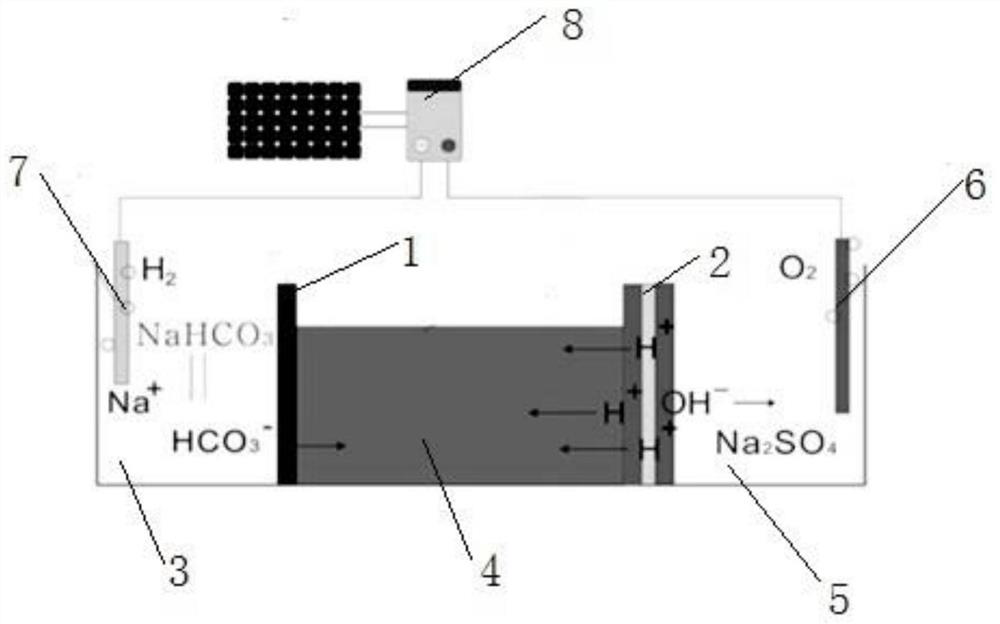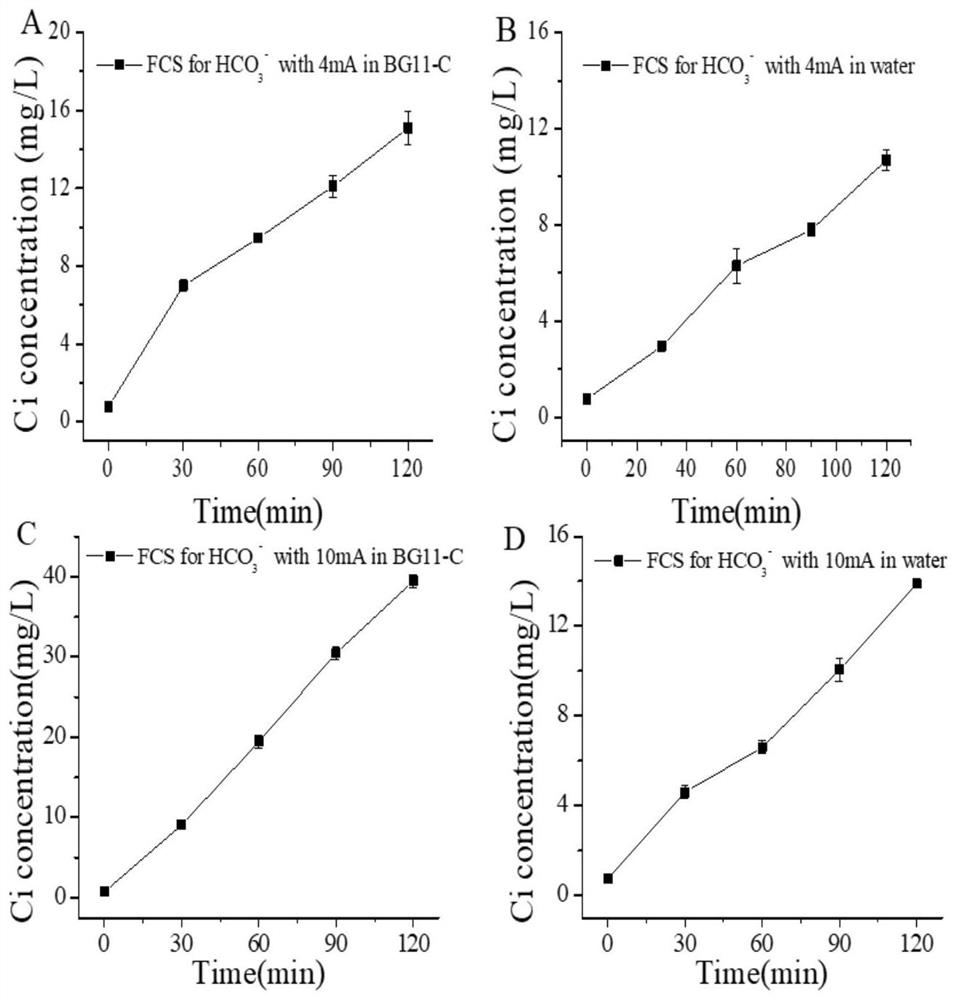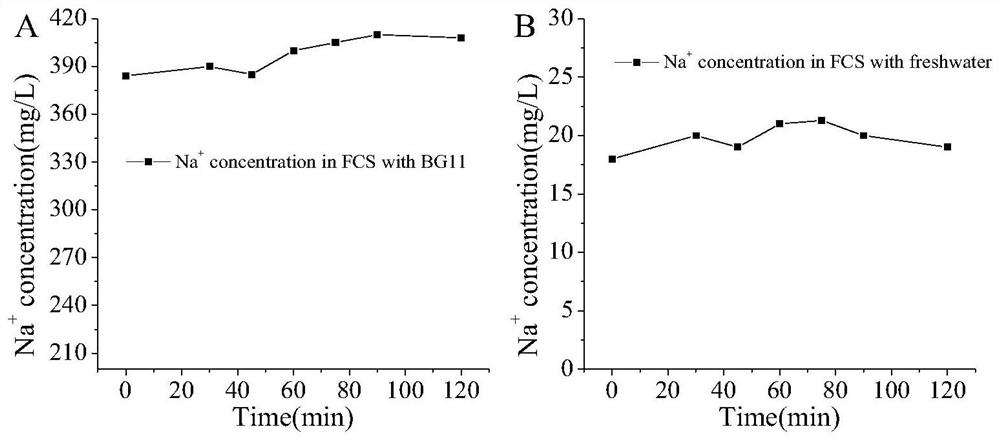Efficient carbon or nitrogen supply device for microalgae autotrophy
A microalgae, high-efficiency technology, used in enzymology/microbiology devices, biochemical cleaning devices, specific-purpose bioreactors/fermenters, etc. Low solubility and other problems, to achieve the effect of facilitating industrialization and application, promoting the growth of microalgae cells, and increasing the culture density
- Summary
- Abstract
- Description
- Claims
- Application Information
AI Technical Summary
Problems solved by technology
Method used
Image
Examples
Embodiment 1
[0040] The anion membrane and the bipolar membrane are selected and assembled into a cathode chamber and an anode chamber respectively, wherein the anode side of the bipolar membrane faces the microalgae chamber. The electrode selects stable inert electrode graphite, and the external power supply is supplied by alternating current through the Bio-Rad protein electrophoresis instrument. Sodium bicarbonate is added to the cathode chamber and sodium sulfate is added to the anode chamber. The graphite electrode is inserted into the chamber 3cm, and the microalgae chamber uses BG11-C or water as the medium to supply carbon for 2 hours by adjusting the current size of 4-10mA, and samples are taken every 20 minutes to detect the content of sodium ions and the amount of carbon supplied. Among them, the sodium ion is determined by the TP330 sodium ion detector for detection, and the carbon determination method adopts the institute's TIC determination method, NO 3 - The determination ...
Embodiment 2
[0044] The anion membrane and the bipolar membrane are selected and assembled into a cathode chamber and an anode chamber respectively, wherein the anode side of the bipolar membrane faces the microalgae chamber. The electrode selects stable inert electrode graphite, and the external power supply is supplied by alternating current through the Bio-Rad protein electrophoresis instrument. Sodium nitrate is added to the cathode chamber and sodium sulfate is added to the anode chamber. The graphite electrode is inserted into the chamber 3cm, and the microalgae chamber uses BG11-N or water as the medium to supply carbon for 2 hours by adjusting the current size of 4-10mA, and samples are taken every 20 minutes to detect the sodium ion content and carbon supply. Among them, the sodium ion is determined by the TP330 sodium ion detector for detection, and the carbon determination method adopts the institute's TIC determination method, NO 3 - The determination method adopts spectropho...
Embodiment 3
[0047] The anion membrane and the bipolar membrane are selected and assembled into a cathode chamber and an anode chamber respectively, wherein the anode side of the bipolar membrane faces the microalgae chamber. The electrode selects stable inert electrode graphite, and the external power supply is supplied by alternating current through the Bio-Rad protein electrophoresis instrument. Sodium bicarbonate is added to the cathode chamber and sodium sulfate is added to the anode chamber. Graphite electrodes are inserted into the chamber for 5cm, and after 3-10 minutes of power-on, the power supply current is controlled at 4-1000mA. The microalgae chamber uses BG11-C or water as the medium, and the microalgae to be cultured and the culture solution are put into the self-supporting microalgae. Self-supporting in high-efficiency carbon or nitrogen supply devices; real-time monitoring of the pH value of the microalgae chamber. If the pH value of the microalgae chamber is lower than 6...
PUM
 Login to View More
Login to View More Abstract
Description
Claims
Application Information
 Login to View More
Login to View More - R&D
- Intellectual Property
- Life Sciences
- Materials
- Tech Scout
- Unparalleled Data Quality
- Higher Quality Content
- 60% Fewer Hallucinations
Browse by: Latest US Patents, China's latest patents, Technical Efficacy Thesaurus, Application Domain, Technology Topic, Popular Technical Reports.
© 2025 PatSnap. All rights reserved.Legal|Privacy policy|Modern Slavery Act Transparency Statement|Sitemap|About US| Contact US: help@patsnap.com



